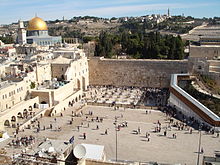
Back Portal:Judetum ALS بوابة:اليهودية Arabic Википедия:Портал:Йәһүдилек Bashkir Portal:Judndum BAR Portál:Hebraistika Czech Portal:Judentum German Portal:Cıhudiye DIQ Portalo:Judismo Esperanto Portal:Judaísmo Spanish Portail:Judaïsme French
The Judaism PortalJudaism (Hebrew: יַהֲדוּת, romanized: Yahăḏūṯ) is an Abrahamic monotheistic ethnic religion that comprises the collective spiritual, cultural, and legal traditions of the Jewish people. Judaism evolved from Yahwism, an ancient Semitic religion of the late Bronze Age to early Iron Age, likely around the 6th/5th century BCE. Along with Samaritanism, to which it is closely related, Judaism is one of the two oldest Abrahamic religions. Religious Jews regard Judaism as their means of observing the Mosaic covenant, which was established between God and the Israelites, their ancestors. Jewish religious doctrine encompasses a wide body of texts, practices, theological positions, and forms of organization. Among Judaism's core texts is the Torah, the first five books of the Hebrew Bible, a collection of ancient Hebrew scriptures. The Tanakh, known in English as the Hebrew Bible, is also referred to as the "Old Testament" in Christianity. In addition to the original written scripture, the supplemental Oral Torah is represented by later texts, such as the Midrash and the Talmud. The Hebrew-language word torah can mean "teaching", "law", or "instruction", although "Torah" can also be used as a general term that refers to any Jewish text that expands or elaborates on the original Five Books of Moses. Representing the core of the Jewish spiritual and religious tradition, the Torah is a term and a set of teachings that are explicitly self-positioned as encompassing at least seventy, and potentially infinite, facets and interpretations. Judaism's texts, traditions, and values strongly influenced later Abrahamic religions, including Christianity and Islam. Hebraism, like Hellenism, played a seminal role in the formation of Western civilization through its impact as a core background element of Early Christianity. (Full article...) Selected ArticleThe Acra was a fortified compound in Jerusalem of the 2nd century BCE. Built by Antiochus Epiphanes, ruler of the Seleucid Empire, following his sack of the city in 168 BCE, the fortress played a significant role in the events surrounding the Maccabean Revolt and the formation of the Hasmonean Kingdom. It was destroyed by Simon Maccabeus during this struggle. The exact location of the Acra, critical to understanding Hellenistic Jerusalem, remains a matter of ongoing discussion. Historians and archaeologists have proposed various sites around Jerusalem, relying mainly on conclusions drawn from literary evidence. This approach began to change in the light of excavations which commenced in the late 1960s. New discoveries have prompted reassessments of the ancient literary sources, Jerusalem's geography and previously discovered artifacts. Yoram Tsafrir has interpreted a masonry joint in the southeastern corner of the Temple Mount platform as a clue to the Acra's possible position. During Benjamin Mazar's 1968 and 1978 excavations adjacent to the south wall of the Mount, features were uncovered which may have been connected with the Acra, including barrack-like rooms and a huge cistern. (Read more...) Did You Know?Did you know...
Related Categories
Featured Articles
Related PortalsHistory ArticleSimon Wiesenthal (1908–2005) was a Jewish-Austrian Holocaust survivor who became famous after World War II for his work as a Nazi hunter. He studied architecture and was living in Lviv at the outbreak of World War II. After being forced to work as a slave labourer in various Nazi concentration camps during the war, Wiesenthal dedicated most of his life to tracking down fugitive Nazi war criminals. In 1947 he co-founded the Jewish Historical Documentation Center in Linz, Austria, where he and others gathered information for war crime trials and helped refugees find lost relatives. He opened the Jewish Documentation Center in Vienna in 1961. He helped in locating Adolf Eichmann and preparing a dossier on Franz Stangl. In April 1970, when Bruno Kreisky became the Austrian chancellor, Wiesenthal told the press that four cabinet appointees had been members of the Nazi Party. Kreisky called Wiesenthal a "Jewish Nazi" and likened his organisation to the Mafia. He later accused him of collaborating with the Nazis. In 1986, Wiesenthal was involved in the case of Kurt Waldheim, whose Nazi past was revealed in the lead-up to the 1986 Austrian presidential elections, although Wiesenthal had previously cleared him of any wrongdoing. With a reputation as a storyteller, Wiesenthal wrote several memoirs that contain tales that are only loosely based on actual events. He died in Vienna on 20 September 2005, and was buried in Herzliya. The Simon Wiesenthal Center in Los Angeles is named in his honor. (Read more...) Picture of the Week Excavated stones from the wall of the Second Temple, knocked onto the street below by Roman battering rams in on the 9 Av, 70 CE Credit: Wilson44691 (talk)
In the News
Featured Quote
WikiProjectsThings You Can Do
Weekly Torah Portion
TopicsAssociated WikimediaThe following Wikimedia Foundation sister projects provide more on this subject:
Discover Wikipedia using portals | |||||||||
© MMXXIII Rich X Search. We shall prevail. All rights reserved. Rich X Search


























